Clay vessels provide an excellent natural solution for storing your dry foods. You'll benefit from their porous nature that allows proper airflow while maintaining ideal moisture levels. These containers help extend shelf life through temperature regulation and acidity neutralization, cutting down on food waste. As a bonus, the clay can enrich your stored foods with minerals like calcium and iron. To get started, choose properly fired vessels, clean them with mild soap, and store them in well-ventilated areas away from freezing temperatures. By exploring traditional clay storage methods, you'll discover even more ways to preserve your pantry items naturally.
Why Choose Clay Storage Vessels
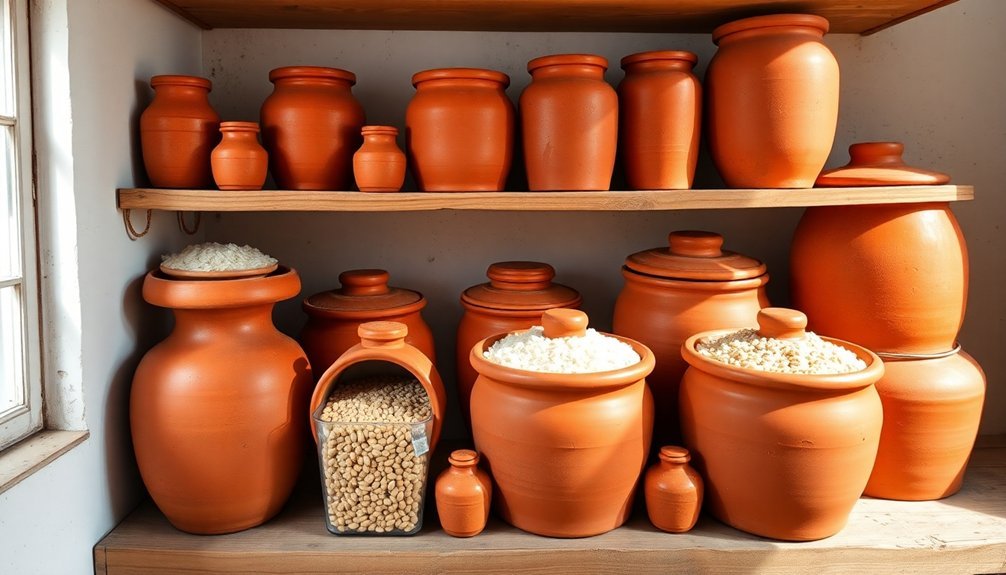
Clay vessels stand out from other storage options due to their remarkable natural properties and versatile benefits. Their porous nature creates a unique environment that allows your dry foods to breathe while maintaining ideal moisture levels. This natural circulation helps prevent spoilage and keeps your stored items fresher for longer periods. No soap or detergent should be used when cleaning these vessels to prevent chemical absorption into stored foods.
You'll find that clay containers offer superior preservation qualities compared to metal or plastic alternatives. The alkaline properties of clay help neutralize acidity, while the vessel's natural ability to regulate temperature and humidity guarantees your dry goods stay in prime condition. They're particularly effective in hot climates, as clay's cooling properties can maintain temperatures considerably lower than the surrounding environment.
When you store your dry foods in clay vessels, you're also making an environmentally conscious choice. These containers are biodegradable, non-toxic, and cost-effective, typically ranging from $5 to $40 depending on size.
You'll appreciate how clay vessels help reduce food waste by extending the shelf life of your stored items. Plus, you're getting the added benefit of natural mineral enrichment, as clay can impart beneficial nutrients like calcium, phosphorous, and iron to your stored foods.
Preparing Your Clay Containers
Now that you understand the benefits of clay vessels, preparing your own containers requires careful attention to material selection and technique.
You'll need to start by finding suitable clay in your area – look for soil that cracks when it dries and can form a rope that bends without breaking when rolled between your hands. Clay with excessive sand content won't work well, as it'll crack during the drying process. The gradual two-week drying period is essential before proceeding with firing to prevent cracking and ensure durability.
Once you've found good clay, follow these essential steps:
- Break off an orange-sized piece of clay and work it in your hands until it becomes pliable and uniform in consistency.
- Mix in tempering agents like crushed rock, wood ash, or pottery shards to control thermal shock and reduce shrinkage.
- Shape your container as desired, then let it dry in the shade for about an hour before adding any decorative elements.
- Fire the container at high temperatures to create mullite, making it strong and water-resistant.
Remember to keep your containers away from direct sunlight during the drying phase, and make sure you've mixed the tempering agents thoroughly throughout the clay.
This careful preparation will result in durable containers that'll effectively store your dry goods.
Best Dry Foods for Clay
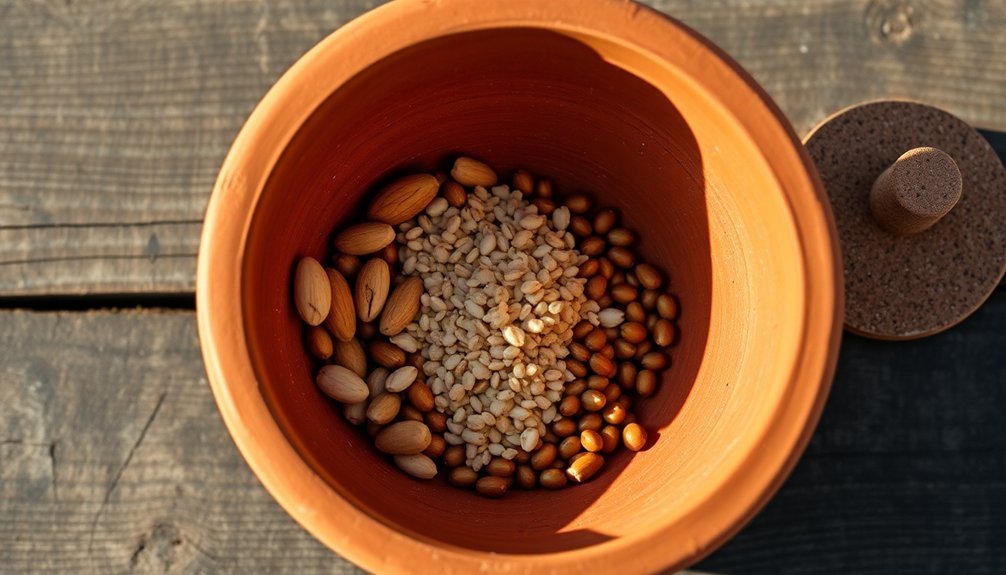
You'll find that clay containers work wonderfully for storing basic grains and cereals, as they help maintain ideal moisture levels while preventing spoilage.
To protect against moisture damage, store clay vessels in well-lit areas to minimize the risk of mold development.
Your favorite spices can stay fresh longer in clay vessels when you use proper liners and keep them away from direct sunlight.
When storing legumes in clay containers, make sure to seal them properly and check regularly for any signs of moisture or pest issues.
Grains and Cereals Storage
Ancient civilizations understood the power of clay vessels for storing grains and cereals, and this wisdom holds true today. Clay pots, when properly fired, create a natural barrier against moisture and pests while maintaining the quality of your stored grains.
You'll find that these traditional methods are still effective, especially when combined with modern hermetic storage principles.
To maximize your grain storage success in clay vessels, follow these essential steps:
- Confirm your grains have the correct moisture content (around 14%) before storage to prevent spoilage.
- Fire your clay containers thoroughly to achieve water resistance and durability.
- Seal your vessels properly using natural or latex-based materials to create a hermetic environment.
- Clean and maintain your storage containers regularly to prevent pest infestations.
You can further enhance your clay storage system by placing containers in a cool, dry area of your home.
While modern commercial storage solutions exist, properly managed clay vessels offer similar benefits without requiring complex supply chains.
They're particularly effective when combined with hermetic sealing techniques, which can reduce oxygen levels and control insect populations naturally, helping you maintain high grain quality for extended periods.
Spices Stay Fresh Longer
Among all dry foods, spices benefit exceptionally well from clay vessel storage due to their natural moisture-regulating properties. You'll find that unglazed clay containers, when properly seasoned, create an ideal environment for your spices by maintaining suitable humidity levels and protecting them from external factors that can degrade their quality.
To maximize your spices' shelf life, you'll want to store them in airtight clay containers away from heat sources and direct sunlight. You can enhance the storage conditions by using humidity disks or bisque-fired clay pieces, which help regulate moisture within the container.
While whole spices can last longer, ground spices require more attention to maintain their potency.
For best results, you'll need to season your clay vessels before use and inspect them regularly for signs of cracking. While government guidelines suggest spices can last up to four years, you'll get the most flavor by replacing them every six months.
Remember to check your spices periodically for any changes in color or aroma, as these are indicators that it's time for a replacement.
Legumes in Clay Containers
Contrary to popular belief, legumes aren't suitable for clay container storage due to their unique moisture sensitivity. The high humidity levels in clay pot coolers can quickly turn your dried beans, lentils, and peas into a spoiled mess.
While clay containers work well for many foods, they create an environment that's far too humid for legumes to maintain their quality and nutritional value.
To properly store your legumes and extend their shelf life, follow these essential steps:
- Choose airtight containers made of glass or plastic with tight-fitting lids
- Store in a cool, dry location away from direct sunlight
- Keep the storage area well-ventilated to prevent moisture buildup
- Check regularly for signs of moisture or spoilage
You'll want to avoid clay pot coolers entirely for legume storage, as they create conditions that promote sprouting and mold growth.
Instead, focus on maintaining a dry environment that preserves your legumes' freshness. By storing them properly in airtight containers, you'll protect their nutritional value and save money by preventing waste.
Clay Vessel Selection Guide
When selecting clay vessels for dry food storage, you'll need to take into account three key factors: the size that matches your storage needs, the quality of the lid's seal to prevent moisture infiltration, and whether to choose glazed or unglazed clay.
A well-fitted lid with a tight seal is essential for maintaining the ideal moisture levels, while the vessel size should accommodate your typical food quantities with some extra room for air circulation.
You'll find that glazed vessels offer better protection against moisture and are easier to clean, though unglazed options can provide superior temperature regulation through natural evaporative cooling.
Choosing Right Clay Size
Selecting the right clay vessel size is essential for maintaining the freshness of your dry foods and optimizing kitchen storage. You'll want to choose containers that can fully accommodate the contents of your original packaging while considering your available space and daily usage needs.
When determining the ideal size for your clay vessels, consider these key factors:
- Storage quantity: Select vessels that can hold your typical purchase amounts – for instance, if you buy flour in 5-pound bags, choose a container that fits this volume with some extra headspace.
- Usage frequency: Pick sizes that match how often you'll access the ingredients – smaller containers work better for frequently used items like nuts or grains.
- Kitchen space: Consider your shelf dimensions and available storage area – slim or compact designs can help maximize limited space.
- Handling comfort: Choose sizes you can lift and maneuver safely, especially for heavier ingredients like flour or sugar.
Remember to measure your storage space and consider the vessel's shape before purchasing. Square or rectangular containers often maximize space efficiency, while cylindrical designs can be useful if you plan to nest multiple containers together.
Lid and Seal Features
A proper lid and seal system forms the cornerstone of effective dry food storage in clay vessels. You'll need to guarantee your vessel has a well-fitting lid that creates an airtight seal, typically featuring a rim that fits snugly into the container or includes a slight overlap.
If you're using traditional clay vessels, you might find options with bamboo or wooden lids that provide natural sealing properties. To enhance your vessel's seal, you can apply natural materials like beeswax or incorporate silicone gaskets.
You'll want to test the seal's effectiveness by checking for gaps when the lid is closed. If you notice any issues, consider using a cloth or paper gasket to improve the seal's performance.
You'll need to maintain your lid and seal regularly to guarantee they continue functioning properly. Clean both the lid and vessel with a soft cloth and mild detergent, avoiding harsh chemicals that could damage the materials.
After cleaning, make sure you dry the components thoroughly. You can occasionally apply natural wax to maintain the seal's effectiveness, and always store your vessel in a dry, well-ventilated area away from direct sunlight.
Glazed Vs Unglazed Options
Two distinct options exist when choosing clay vessels for dry food storage: glazed and unglazed varieties. Each type offers unique benefits that can affect how well your dry foods stay fresh and maintain their nutritional value.
- While glazed vessels provide a non-porous, easy-to-clean surface that's more durable and resistant to temperature changes, they don't offer the natural benefits of unglazed clay's moisture regulation.
- Unglazed vessels excel at maintaining ideal humidity levels for dry foods through their porous nature, which helps preserve freshness and nutrients while offering natural EMF protection.
- If you're storing grains and legumes, you'll find unglazed clay particularly effective as it can enhance nutritional value through beneficial mineral leaching and maintain suitable moisture levels.
- For those prioritizing easy maintenance, glazed vessels are your best choice as they're simpler to clean and won't leach minerals into stored foods.
When selecting between the two, consider your specific storage needs. If you're willing to put in extra maintenance effort for better food preservation, choose unglazed clay. If you want durability and easy cleaning, opt for glazed vessels.
Proper Storage Methods
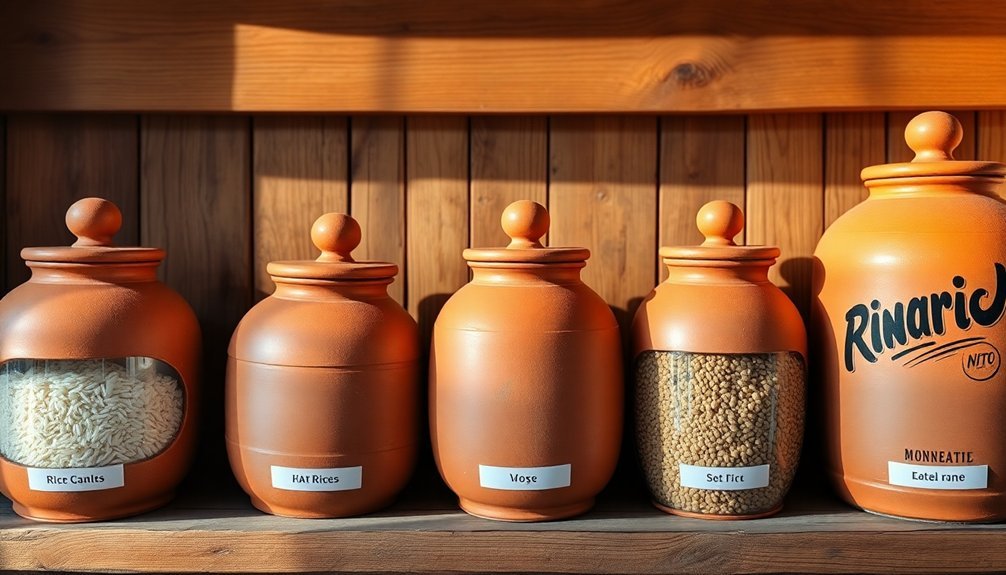
When storing dry foods in clay pot coolers, proper setup and maintenance are essential for ideal preservation. You'll need to start by choosing the right design – either a pot-in-pot system, clay pot in plastic basin, or clay pot in clay dish setup. Guarantee there's a 3-5 cm gap between vessels for sand placement.
| Storage Method | Requirements | Maintenance |
|---|---|---|
| Pot-in-Pot | Two clay pots, sand | Daily water check |
| Basin Setup | Clay pot, plastic/metal basin | Regular sand moistening |
| Clay Dish | Clay pot and dish | Keep cloth cover damp |
| Ventilation | Shaded area | Monitor airflow |
| Cleanliness | Regular washing | Remove debris weekly |
To maintain your cooler effectively, you'll need to clean the sand through a wire mesh and winnowing process. Place the sand carefully between the vessels, guaranteeing even distribution. Don't overwater – the sand should be damp but not saturated. Cover the top with a wet cloth or burlap, and keep the cooler in a shady, well-ventilated spot. Remember to separate ethylene-producing items from sensitive produce, and avoid storing strong-smelling foods together.
Moisture Control Techniques
Maintaining proper moisture control in dry food storage requires multiple defense strategies to prevent spoilage and maintain quality.
You'll need to combine several methods to create an environment that keeps your dry foods at their best while preventing condensation and moisture damage.
- Start with desiccants placed strategically in your storage area – they're your first line of defense. You can use silica gel packets or calcium chloride containers, but remember to replace them regularly as they become saturated.
- Install proper ventilation to keep air moving. You'll want to add grate-style or louver vents to help equalize temperatures and prevent moisture buildup. If possible, use exhaust fans to improve airflow even further.
- Don't skip insulation – it's essential for preventing temperature fluctuations that lead to condensation. You can use foam insulation or foil-encased bubble wraps on walls, and don't forget to add aluminum barriers on the floor.
- Consider adding climate control systems if you're storing valuable food items. Dehumidifiers are particularly effective, and you'll want to maintain humidity levels below 40% for ideal storage conditions.
Just make sure you've got easy access to power and a way to handle water removal.
Common Storage Mistakes
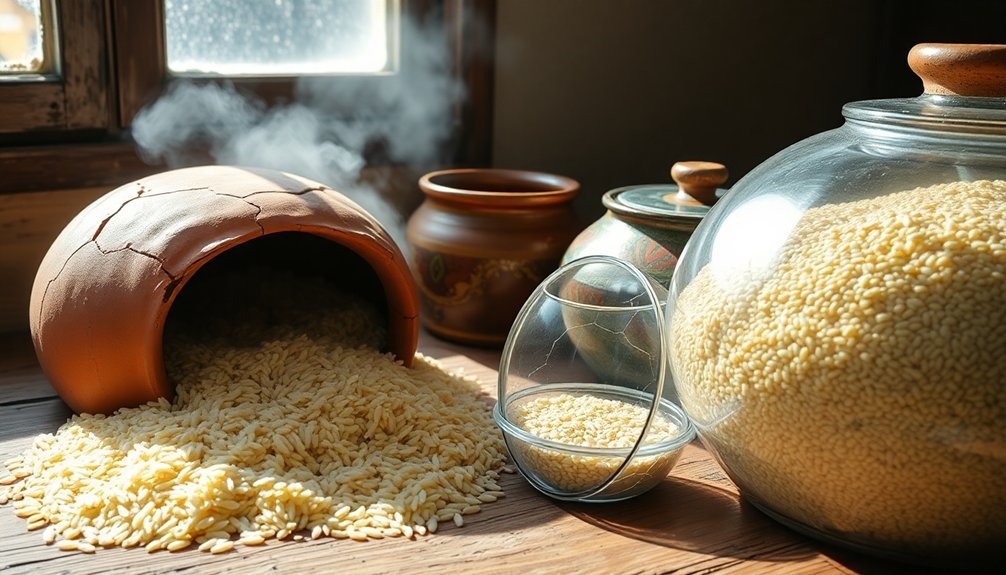
Four critical mistakes can undermine even the best food storage plans. If you're not using airtight containers, you're inviting trouble. Even tiny cracks allow moisture and pests to infiltrate your stored foods, leading to clumping, mold growth, and contamination.
Make certain you're using food-grade containers made of plastic, glass, or metal that seal completely.
Don't skip oxygen absorbers when storing dry goods long-term. These essential tools remove oxygen that can cause food oxidation, nutrient loss, and off-flavors, particularly in grains, nuts, and dried fruits.
They're your first line of defense against bacteria and mold growth.
You'll want to avoid storing food in humid or hot areas like flood-prone basements or temperature-fluctuating garages. Heat above 100°F can spoil canned goods and destroy nutrients, while humidity leads to moisture absorption in dry foods.
Choose storage areas with stable, cool temperatures.
Finally, if you're not rotating your stock, you're setting yourself up for waste. Keep track of storage dates and use the oldest items first.
Regular rotation ensures you're maintaining food quality and preventing items from becoming stale or spoiled.
Natural Food Preservation Benefits
You'll discover that natural preservation methods help maintain the ideal moisture balance in your dry foods while protecting their valuable mineral content.
Natural preservatives work with your food's existing compounds to enhance rather than mask flavors, creating a more authentic taste experience.
The benefits extend beyond just preservation, as many natural methods actually increase the bioavailability of essential minerals and improve the overall nutritional profile of your stored foods.
Natural Moisture Balance
Finding the right moisture balance in dry foods is critical for preserving their freshness and nutritional value. You'll need to understand how moisture content directly affects bacterial growth and shelf life, while implementing proper storage techniques to maintain ideal conditions.
- Use glass containers for storage, as they'll help you easily spot any unwanted moisture buildup and maintain proper ventilation while keeping your dry goods protected from external humidity.
- Keep your dried foods in cool, dark areas with about 10% moisture content for vegetables, and condition fruits to equalize moisture distribution to prevent mold formation.
- Consider natural preservatives like chitosan, tea polyphenols, or rosemary extract to enhance preservation while maintaining moisture balance.
- Monitor storage conditions regularly, as temperature fluctuations can cause condensation and compromise your food's quality.
You can enhance your preservation efforts by combining traditional air drying with modern dehumidification techniques.
Whether you're using natural air circulation or freeze-drying methods, maintaining consistent moisture levels is essential.
For best results, store your dried foods for no longer than 4 months to 1 year, depending on the specific item and storage conditions you've implemented.
Mineral Content Benefits
Beyond maintaining proper moisture levels, understanding the mineral content benefits of dried foods adds another dimension to natural preservation. When you dry foods properly, you'll actually concentrate their mineral content, making them more nutrient-dense than their fresh counterparts.
Natural drying methods help retain minerals better than high-heat processing techniques like canning or pasteurization.
You'll get the most mineral benefits from your dried foods when you store them correctly in cool, dark places. Using clay vessels can help maintain ideal storage conditions, but it's essential to keep them sealed against moisture and air.
By preventing moisture reabsorption, you're protecting both the food's quality and its valuable mineral content.
The bioavailability of essential minerals like iron, zinc, and calcium stays better preserved in properly dried foods. While natural preservation won't enhance mineral bioavailability, it helps maintain existing levels by preventing spoilage.
You can maximize these benefits by choosing storage containers with tight-fitting lids and regularly checking for any signs of moisture. Remember that proper temperature control is key – higher temperatures can reduce both storage time and mineral retention in your dried foods.
Taste Enhancement Properties
Preserving the natural flavors of food becomes remarkably effective through the combination of evaporative cooling and humidity control. When you store your dry foods in clay vessels, you'll benefit from a cooling effect that can reduce temperatures by up to 10°C, which greatly slows down food deterioration and maintains taste quality.
The clay pot's natural properties create an ideal environment for food preservation through these key mechanisms:
- The evaporative cooling process maintains ideal temperatures, extending the shelf life of leafy greens from one day to over four days while preserving their crisp texture.
- The vessel's ability to regulate humidity prevents dehydration and maintains the natural volatile compounds that give foods their distinctive flavors and aromas.
- The controlled environment reduces ethylene gas impact, slowing down the ripening process and preventing unwanted flavor transfers between different foods.
- The stable conditions inhibit microbial growth, ensuring your stored foods remain safe while retaining their original taste profiles.
Clay Vessel Maintenance Tips
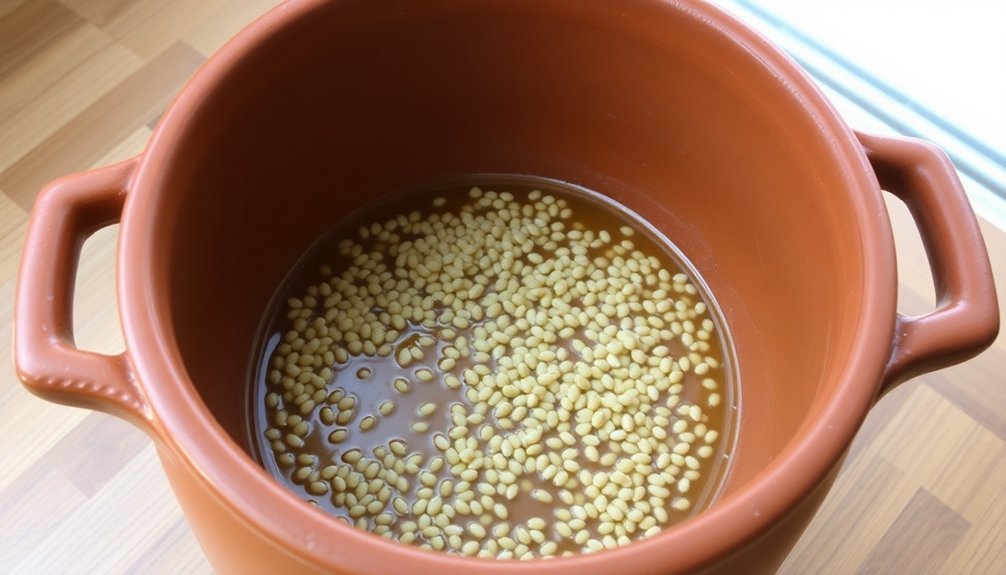
Proper maintenance of clay vessels calls for careful attention to both initial preparation and ongoing care.
Before first use, you'll need to soak your pot in water overnight and season it with coconut oil or ghee. Complete the seasoning by heating rice water on low flame, then fry an onion to remove any mud smell.
When cleaning your clay vessels, use mild dish soap and a soft sponge – never steel scrubbers or harsh detergents. Don't soak the pot in soapy water, as it'll absorb chemicals. For stubborn stains, try natural cleaners like baking soda, salt, or lemon slices mixed with water.
You'll need to handle your clay vessels with extra care to prevent damage. Store them in a well-ventilated area, and make sure they're completely dry to prevent mold growth. When stacking, use protective padding between pieces.
While cooking, stick to low or medium heat to avoid thermal shock. Don't heat an empty pot, and always use wooden or silicone utensils.
After each use, clean with rice flour or salt to maintain the pot's condition. Remember, these vessels aren't suitable for freezer use due to their porous nature.
Traditional Storage Wisdom
Ancient traditions hold invaluable lessons for storing dry foods in clay vessels. You'll find that many time-tested practices from historical civilizations remain relevant today, especially when it comes to maintaining ideal storage conditions for grains and legumes.
- Position your clay vessels in cool, shady areas with good ventilation to prevent moisture buildup and maintain consistent temperatures – just as ancient civilizations did by using cellars and underground storage spaces.
- Pack your dry goods tightly into the vessels, leaving minimal empty space, and seal them properly with fitted lids to create an airtight environment that keeps pests out.
- Consider placing sand or other natural desiccants around your clay vessels to control humidity levels, a technique that's particularly effective in areas with varying climate conditions.
- Store your vessels in locations with steady temperatures, avoiding areas prone to extreme fluctuations.
If you're in an arid climate, you can take advantage of natural drying conditions, but you'll need to adapt your storage approach based on your local environment.
While clay vessels mightn't match modern storage methods' effectiveness, they're sustainable, cost-effective, and remarkably reliable when used correctly.
Frequently Asked Questions
Can Clay Vessels Be Used to Store Spices Without Losing Their Aroma?
Yes, you can store spices in clay vessels effectively. They'll help maintain your spices' aroma through natural moisture regulation, but you'll need to keep them in a cool, dark place for best results.
How Long Does a Clay Vessel Need to Be Seasoned Before First Use?
You'll need to season your clay vessel for at least 2-3 days. First soak it overnight, then complete the oil seasoning process which includes boiling water and cooking with onions.
Do Different Types of Clay Affect the Storage Quality of Dry Foods?
Yes, clay type affects storage quality. You'll find stoneware works best for dry foods since it's less porous than earthenware. While porcelain's ideal, it's pricier. Always guarantee your vessel's properly glazed.
What Happens if Metal Utensils Are Used to Scoop From Clay Containers?
When you use metal utensils in clay containers, you'll risk scratching the surface and causing chemical reactions. The metal can interact with the clay, potentially affecting your food's taste and safety over time.
Can Clay Vessels Be Stacked on Top of Each Other During Storage?
You shouldn't stack clay vessels directly on top of each other unless they're completely dry. If you must stack them, use a wire rack or trivet between each piece to guarantee proper air circulation.
In Summary
You've discovered an ancient yet effective way to store your dry goods that's both sustainable and practical. By following proper preparation methods, selecting the right vessels, and maintaining them correctly, you'll enjoy fresher ingredients while honoring traditional storage wisdom. Whether you're storing grains, legumes, or spices, clay vessels can become your go-to storage solution, keeping your pantry naturally organized and your foods well-preserved.

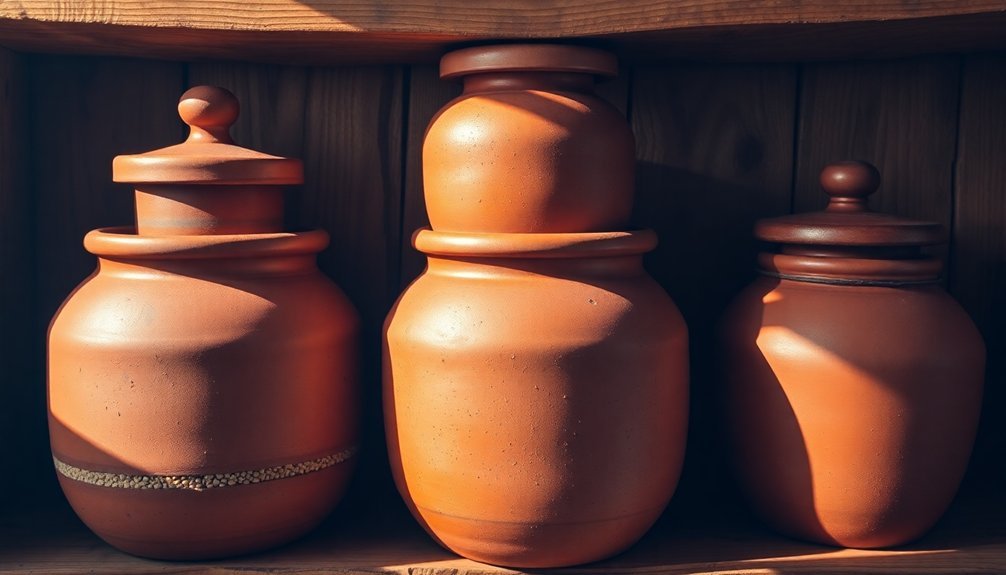



Leave a Reply